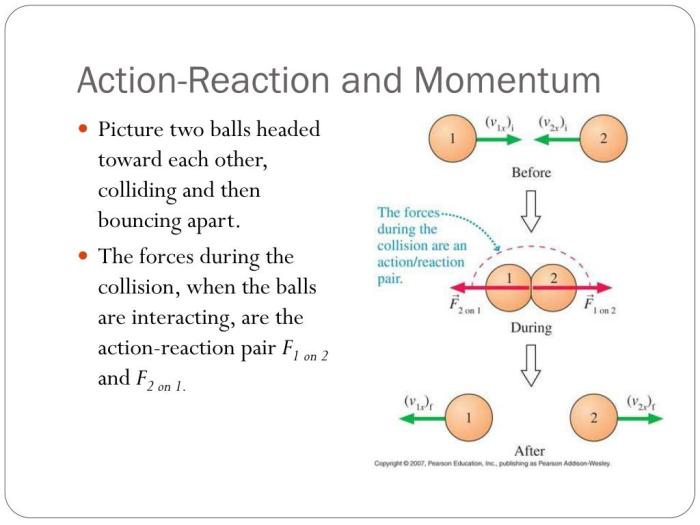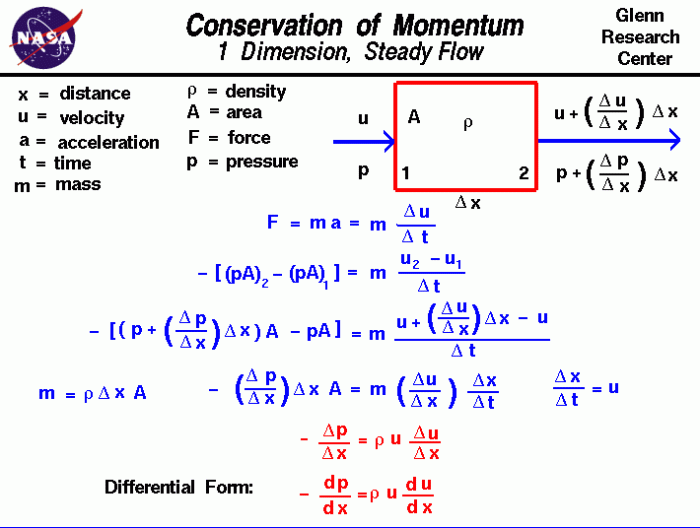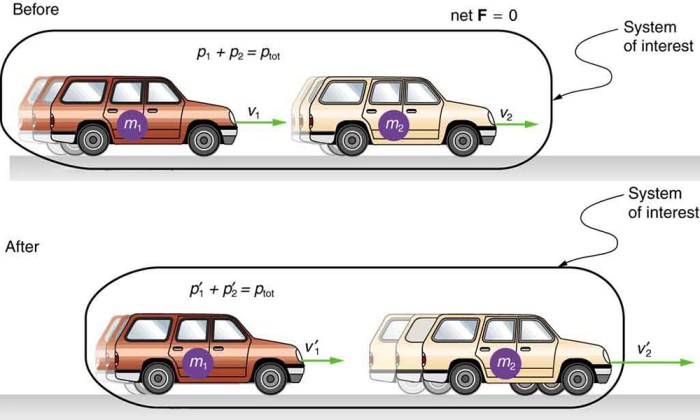Action reaction and momentum conservation answers – Delving into the realm of physics, we embark on an exploration of action reaction and momentum conservation, unraveling their profound implications in our world. From everyday occurrences to celestial phenomena, these principles govern the motion and interactions of objects, providing a framework for understanding the dynamic universe around us.
Action and reaction forces, the cornerstone of Newton’s Third Law, manifest themselves in countless scenarios, from the propulsion of rockets to the simple act of walking. Momentum, a fundamental property of moving objects, remains constant in closed systems, offering valuable insights into collisions, explosions, and a myriad of other physical events.
1. Newton’s Third Law of Motion
Action and Reaction
Newton’s third law of motion states that for every action, there is an equal and opposite reaction. This means that when one object exerts a force on another object, the second object exerts an equal and opposite force on the first object.
For example, when you push against a wall, the wall pushes back on you with the same amount of force.
Action and Reaction Force Pairs in Everyday Life
- When you walk, you push against the ground with your foot. The ground pushes back on you with an equal and opposite force, propelling you forward.
- When you swim, you push against the water with your arms and legs. The water pushes back on you with an equal and opposite force, propelling you through the water.
- When you fire a gun, the gun exerts a force on the bullet, propelling it forward. The bullet exerts an equal and opposite force on the gun, causing it to recoil.
Relationship Between Action and Reaction Forces
The magnitude of the action force is always equal to the magnitude of the reaction force. However, the direction of the action force is always opposite to the direction of the reaction force.
2. Momentum Conservation in Collisions
Momentum is a measure of an object’s mass and velocity. Momentum is a conserved quantity, which means that the total momentum of a system of objects remains constant as long as no external forces act on the system.
Types of Collisions
- Elastic collisionsare collisions in which the total kinetic energy of the system is conserved. This means that the objects bounce off each other without losing any energy.
- Inelastic collisionsare collisions in which the total kinetic energy of the system is not conserved. This means that the objects stick together or lose some of their energy due to friction or other forces.
Momentum Conservation in Real-World Scenarios
- When two billiard balls collide, the total momentum of the system is conserved. This means that the two balls will bounce off each other with the same total momentum as they had before the collision.
- When a car crashes into a wall, the total momentum of the system is conserved. This means that the car and the wall will rebound with the same total momentum as they had before the collision.
3. Applications of Momentum Conservation

Momentum conservation is a fundamental principle that has applications in various fields, including:
Ballistics
Momentum conservation is used to calculate the trajectory of a projectile, such as a bullet or a rocket. By knowing the mass and velocity of the projectile, we can calculate how far it will travel and where it will land.
Rocket Propulsion
Momentum conservation is used to explain how rockets work. Rockets propel themselves forward by expelling mass in the form of exhaust gases. The exhaust gases have momentum, and according to Newton’s third law, the rocket experiences an equal and opposite momentum, which propels it forward.
Sports
Momentum conservation is used to explain how athletes can perform amazing feats of strength and agility. For example, a high jumper can use the momentum of their run-up to propel themselves over the bar.
4. Impulse and Momentum Change
Impulse is a measure of the change in momentum of an object. Impulse is calculated by multiplying the force applied to an object by the time over which the force is applied.
Effects of Impulse on Objects in Motion
- Impulse can cause an object to start moving.
- Impulse can cause an object to stop moving.
- Impulse can cause an object to change its direction of motion.
Examples of Impulse
- When you kick a soccer ball, you apply an impulse to the ball, causing it to start moving.
- When you catch a baseball, you apply an impulse to the ball, causing it to stop moving.
- When you hit a golf ball, you apply an impulse to the ball, causing it to change its direction of motion.
5. Experimental Verification of Momentum Conservation: Action Reaction And Momentum Conservation Answers

Momentum conservation has been experimentally verified in numerous experiments. One of the most famous experiments is the Atwood machine.
Atwood Machine
The Atwood machine is a simple device that consists of two masses connected by a string that passes over a pulley. When the masses are released, they accelerate in opposite directions. The acceleration of the masses can be measured, and the momentum of the system can be calculated.
The results of the experiment show that the total momentum of the system is conserved.
6. Advanced Applications of Momentum Conservation

Momentum conservation is a powerful tool that has applications in various advanced fields, including:
Fluid Dynamics
Momentum conservation is used to explain the flow of fluids, such as water and air. By understanding the momentum of a fluid, we can design more efficient aircraft, ships, and other fluid-based systems.
Astrophysics, Action reaction and momentum conservation answers
Momentum conservation is used to explain the motion of stars and planets. By understanding the momentum of these objects, we can better understand the formation and evolution of the universe.
Nuclear Physics
Momentum conservation is used to explain the interactions of subatomic particles. By understanding the momentum of these particles, we can better understand the structure of atoms and the forces that hold them together.
Question Bank
What is the relationship between action and reaction forces?
Action and reaction forces are always equal in magnitude and opposite in direction, acting on different objects.
How does momentum conservation apply to collisions?
In a closed system, the total momentum before a collision is equal to the total momentum after the collision.
What is the significance of impulse in momentum change?
Impulse is the product of force and time, and it is equal to the change in momentum of an object.
